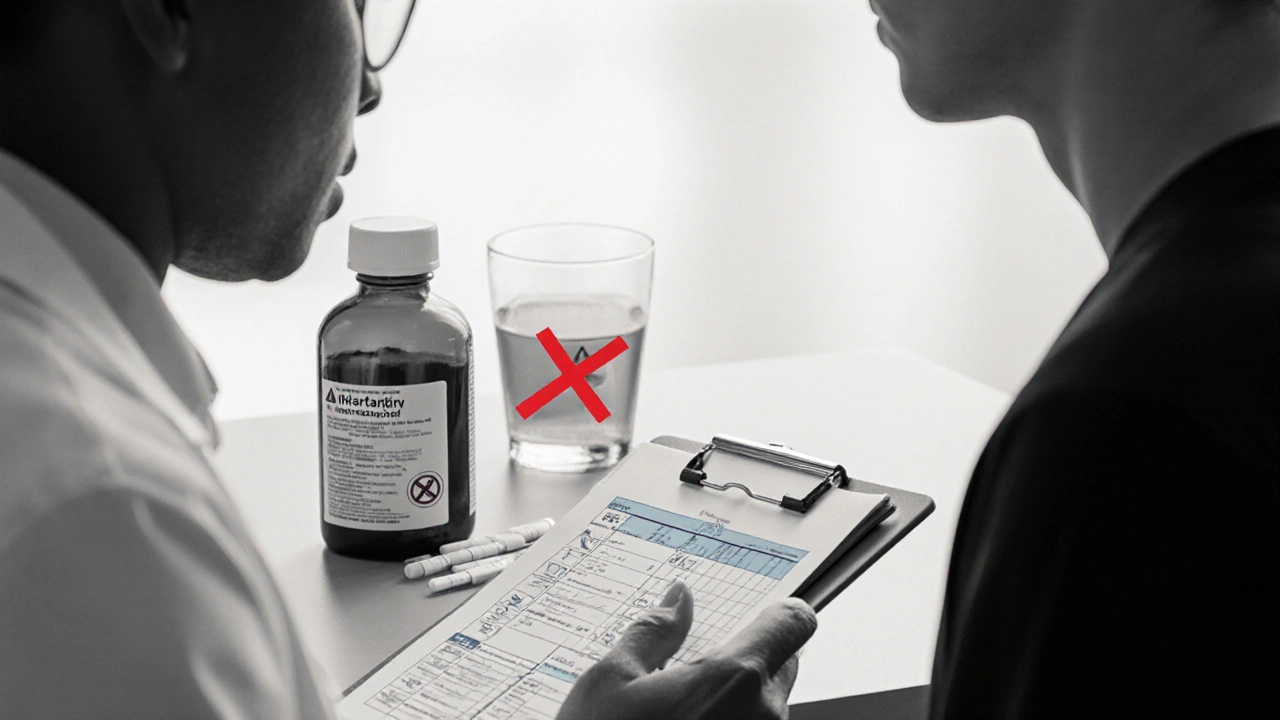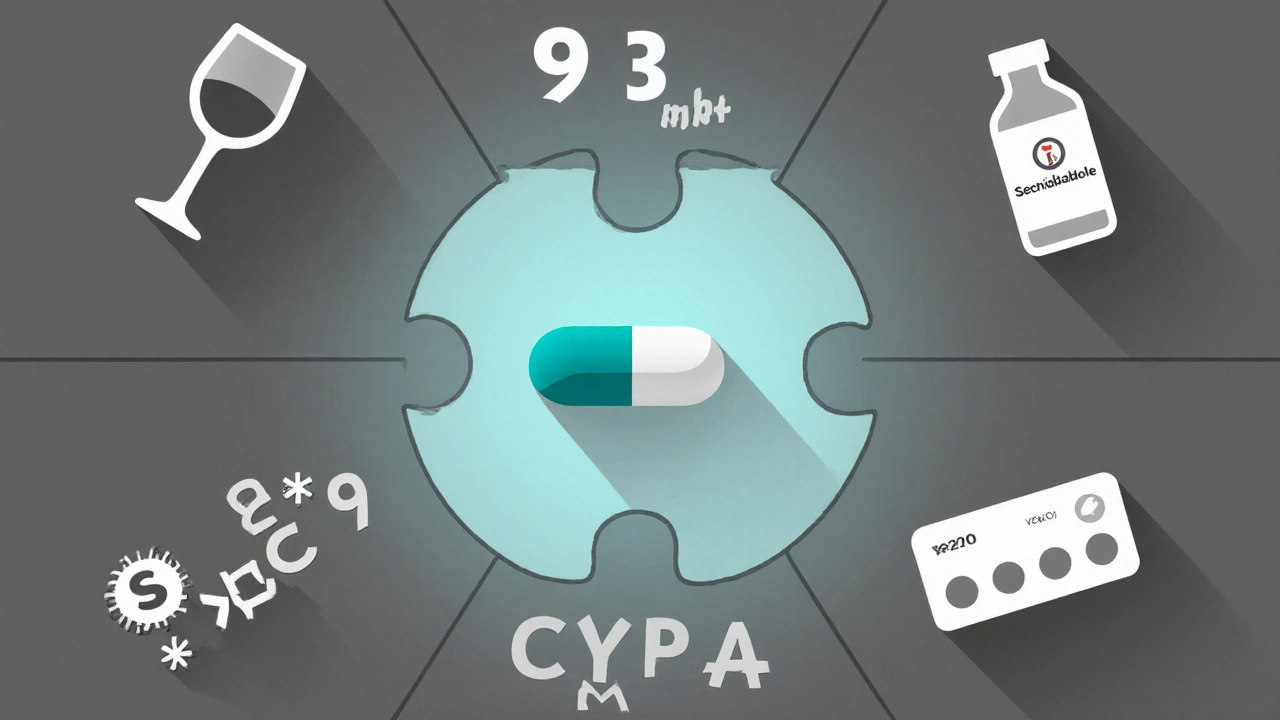Understanding secnidazole interactions can feel like decoding a puzzle, especially when you’re juggling other meds, alcohol, or health conditions. This guide breaks down the most common and serious combos, shows you how to spot red flags, and offers practical steps to keep your treatment safe.
What Is Secnidazole?
When prescribing Secnidazole is a nitroimidazole antibiotic that targets anaerobic bacteria and certain protozoa. It’s most often used as a single‑dose therapy for bacterial vaginosis and trichomoniasis. Because it stays in the body for about 24hours (half‑life ~12-14hours), you usually take one tablet and finish the treatment without a follow‑up dose.
Why Drug Interactions Matter
Like any medication, secnidazole can change how other drugs work or be affected by them. Interactions may amplify side effects, reduce effectiveness, or trigger dangerous reactions. Knowing the culprits helps you and your clinician manage risks before they become problems.
Common Interaction Categories
- Other nitroimidazoles - Metronidazole and tinidazole share metabolic pathways.
- Blood thinners - Warfarin’s anticoagulant effect can be enhanced.
- Hormonal contraceptives - Some antibiotics lower estrogen levels.
- Alcohol - Nitroimidazoles may cause a disulfiram‑like reaction.
- Enzyme‑modulating drugs - Substances that affect CYP2C9 or CYP3A4 can alter secnidazole levels.
Interaction Spotlight: Metronidazole and Tinidazole
Both Metronidazole and Tinidazole belong to the same nitroimidazole class. Co‑administration is generally unnecessary and can increase neurotoxicity risk (headaches, seizures). If you’ve recently finished a course of metronidazole, wait at least five days before starting secnidazole.
Blood Thinners and Secnidazole
Warfarin is metabolized partly by CYP2C9. Secnidazole can inhibit this enzyme, raising INR levels and the chance of bleeding. If you’re on warfarin, your doctor should check your INR before the dose and monitor it for 1‑2 weeks after.

Hormonal Contraceptives: A Cautionary Note
Evidence suggests that nitroimidazoles might slightly reduce estrogen levels, potentially decreasing the effectiveness of combined oral contraceptives. While the risk is lower than with rifampin, many clinicians advise using a backup method (condoms) for at least a week after completing secnidazole.
Alcohol: The Disulfiram‑Like Reaction
Consuming alcohol while taking secnidazole can trigger flushing, nausea, vomiting, and rapid heartbeat-similar to the reaction seen with disulfiram. The mechanism involves inhibition of aldehyde dehydrogenase. The safest rule: avoid alcohol for 48hours before and after the secnidazole dose.
Enzyme Modulators: CYP2C9 and CYP3A4
Secnidazole is primarily cleared by the liver enzyme CYP2C9, with a minor role for CYP3A4. Drugs that induce these enzymes (e.g., carbamazepine, phenytoin) may lower secnidazole concentrations, risking treatment failure. Conversely, inhibitors (e.g., fluconazole) can raise levels, increasing side‑effects like nausea and metallic taste.
Quick Reference Table: Secnidazole vs. Metronidazole vs. Tinidazole
| Attribute | Secnidazole | Metronidazole | Tinidazole |
|---|---|---|---|
| Typical indication | Bacterial vaginosis, trichomoniasis | Clostridioides difficile, anaerobic infections | Giardiasis, amoebiasis |
| Dosing regimen | Single 2g oral dose | 500mg PO q8h for 7‑10days | 2g PO single dose or 500mg q12h for 5days |
| Half‑life | 12‑14h | 8‑10h | 13‑14h |
| Common side effects | Nausea, metallic taste | Metallic taste, neuropathy (long‑term) | Headache, dizziness |
| Alcohol interaction | Disulfiram‑like reaction | Disulfiram‑like reaction | Disulfiram‑like reaction |
How to Spot a Potential Interaction
- List every prescription, OTC, supplement, and herbal product you take.
- Check for known culprits: alcohol, warfarin, enzyme inducers/inhibitors.
- Ask your pharmacist if a drug‑drug interaction checker flags secnidazole with any of your meds.
- Watch for new symptoms after the dose-especially unusual bleeding, severe nausea, or neurological signs.
Managing Interactions Safely
When a risky combo is identified, you have three practical options:
- Adjust timing: Space out secnidazole and the interacting drug (e.g., take warfarin in the morning, secnidazole at night).
- Modify dose: Reduce the dose of the interacting drug under medical supervision.
- Switch therapy: Choose an alternative antibiotic like clindamycin for bacterial vaginosis if multiple interactions make secnidazole unsafe.
Special Populations
Pregnant or breastfeeding individuals should discuss secnidazole with their OB‑GYN. Data are limited, but most guidelines categorize it as Pregnancy Category B (no proven risk in animal studies, but human data are scarce). For patients with liver impairment, dose adjustment isn’t typically required because the drug’s single‑dose nature limits accumulation, yet close monitoring is prudent.
Regulatory and Safety Resources
The FDA classifies secnidazole as a prescription‑only medication and lists contraindications such as severe hypersensitivity and known deficiency of glucose‑6‑phosphate dehydrogenase (G6PD). The drug’s label also highlights the need to avoid alcohol and informs clinicians about the warfarin interaction.
Bottom‑Line Checklist Before You Start Secnidazole
- Identify all concurrent meds, especially warfarin, hormonal contraceptives, and enzyme inducers.
- Confirm no alcohol consumption for 48hours pre‑ and post‑dose.
- Ask your doctor to order an INR test if you’re on warfarin.
- Plan a backup contraceptive method for at least seven days after treatment.
- Know the signs of a disulfiram‑like reaction and seek care if they appear.
Frequently Asked Questions
Can I drink alcohol while taking secnidazole?
No. Secnidazole can cause a severe disulfiram‑like reaction with alcohol, leading to flushing, nausea, vomiting, and rapid heartbeat. Avoid alcohol for at least 48hours before and after the dose.
Does secnidazole affect my birth control pills?
The impact is modest, but some clinicians recommend using a backup method (condoms) for a week after treatment to be safe.
What should I watch for if I’m on warfarin?
Secnidazole may increase INR, so have your INR checked before the dose and then 3‑5 days after. Report any unusual bruising or bleeding immediately.
Is it safe to take secnidazole with other antibiotics?
Generally you shouldn’t combine secnidazole with other nitroimidazoles like metronidazole or tinidazole because of overlapping toxicity. If a combination is needed, a specialist should manage dosing and monitoring.
Can people with liver disease take secnidazole?
The single‑dose regimen reduces the risk of accumulation, but patients with moderate to severe liver impairment should be monitored for any unexpected side effects.
By mapping out the key interactions and staying vigilant, you can use secnidazole effectively while minimizing surprise side effects. Always keep an open line with your prescriber or pharmacist-they’re your best resource for personalized safety advice.


Comments
Frank Reed
Make sure you list every med before you start secnidazole. It definatly helps to have a written list. Your pharmacist can run a quick interaction check, and that’ll save you a lot of trouble later. Stay safe and don’t forget to avoid booze for two days around the dose.
October 15, 2025 AT 18:33
Bailee Swenson
If you think you can just ignore the warfarin warning, you’re kidding yourself 🤦♀️🛑. Secnidazole will jack up your INR and you could end up bleeding out. Stop acting reckless and read the label!
October 16, 2025 AT 04:00
tony ferreres
Life is a series of choices, and each medication is a fork in the road 🌿. When you pair secnidazole with another nitroimidazole you’re walking a tightrope of neurotoxicity. Think of your body as a delicate ecosystem; disturbing one part can echo elsewhere. 🌐 Keep a journal of any new sensations after the dose and share it with your clinician. 📝
October 16, 2025 AT 05:23
Kaustubh Panat
One must apprize oneself of the pharmacokinetic intricacies before embarking upon secnidazole therapy. The enzyme milieu, particularly CYP2C9, orchestrates a symphony of metabolic interplays that the layperson often neglects. Ergo, a prudent practitioner will eschew concomitant nitroimidazoles to avert iatrogenic neurotoxicity. Such discernment reflects the quintessence of clinical erudition.
October 16, 2025 AT 09:33
Arjun Premnath
Patients on warfarin should have an INR measurement within 24 hours before taking secnidazole and again three to five days afterward. This allows the clinician to adjust the warfarin dose if the secnidazole raises the INR. Monitoring reduces the risk of serious bleeding.
October 16, 2025 AT 10:56
Mark Haycox
Dont trust those foreign drug guidelines that ignore our own safety standards. Secnidazole may look harmless, but it can mess with blood thinners big time. You need real American labs on it.
October 16, 2025 AT 15:06
frank hofman
Sure, you can mix secnidazole with a cold beeer if you feel lucky 🍻.
October 16, 2025 AT 15:23
ayan majumdar
list all meds before you start secnidazole. dont forget the over the counter stuff just check them
October 16, 2025 AT 20:40
Johnpaul Chukwuebuka
Keep a short list of what you take and show it to your doctor. This simple step can keep you safe.
October 16, 2025 AT 22:03
Erin Johnson
Ah, the joys of navigating secnidazole interactions-nothing says “thrill ride” like a disulfiram‑like reaction after a weekend brunch 🍾. First, let’s address the myth that you can casually sip wine while the drug does its thing; the reality is you’ll feel like you’ve been hit by a firecracker in your throat. Second, the warfarin‑secnidazole tango is not a gentle waltz; it’s a reckless sprint that can push your INR into the danger zone, turning a routine checkup into an emergency room visit. Third, hormonal contraceptives may lose a fraction of their efficacy, so relying solely on the pill is practically inviting a surprise party you didn’t plan. Fourth, the CYP2C9 conduit is a delicate highway-inducers such as carbamazepine will speed the drug out of your system, while inhibitors like fluconazole will park it there, causing nausea that rivals a roller coaster. Fifth, never underestimate the power of a well‑documented medication list; it’s the unsung hero that prevents catastrophic bleedings. Sixth, if you’re on any liver‑affecting regimen, request closer monitoring because the liver is the backstage crew that keeps the show running. Seventh, remember that a single‑dose regimen limits accumulation, but that does not absolve you from vigilance. Eighth, the “quick reference table” isn’t just decoration; it’s a cheat sheet for the busy clinician and a lifeline for you. Ninth, the disulfiram‑like reaction is not a mild inconvenience; it’s a full‑blown physiological alarm that can include vomiting, flushing, and a heartbeat that feels like a marching band. Tenth, the best defense is a proactive one-talk to your pharmacist, schedule that INR test, and set a reminder to avoid alcohol for 48 hours on either side. Eleventh, the backup contraception rule isn’t optional; it’s a safety net that catches you when the hormonal net tears. Twelfth, if you notice any unusual bruising, neurological tingles, or a metallic taste that lingers, call your provider immediately. Thirteenth, don’t let incomplete information be the reason you end up in the ER; knowledge is the ultimate antidote. Fourteenth, the FDA label is not a suggestion box-it’s a binding document that should guide your actions. Fifteenth, when in doubt, err on the side of caution and avoid the combination that looks tempting but is fraught with risk. Sixteenth, and finally, celebrate the fact that you’re taking charge of your health, because nothing is more empowering than a well‑informed patient who walks into the clinic armed with facts and a fearless attitude.
October 17, 2025 AT 02:13
Bernard Lingcod
Your dramatic recap hits all the high notes, and I’ll definitely keep a pen handy for that medication list. Thanks for the thorough reminder.
October 17, 2025 AT 03:36